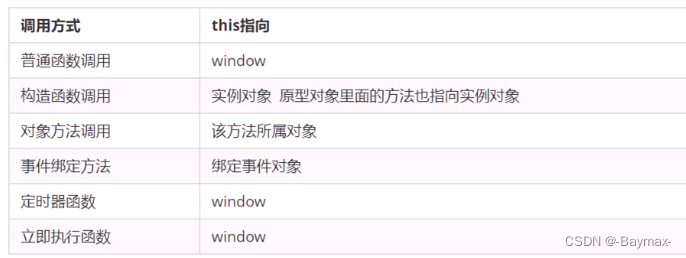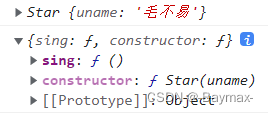一、函数的定义方式
- 函数声明方式 function 关键字(命名函数)
function fn() {
}
- 函数表达式(匿名函数)
let fn = function() {
}
new Function('参数1', '参数2', '参数3')
let f = new Function('a', 'b', 'console.log(a + b)')
f(1, 2) //3
- 所有函数都是 Function 的实例(对象)。函数也属于对象。

let f = new Function('a', 'b', 'console.log(a + b)')
f(1, 2)
console.log(f instanceof Object) //true
二、函数的调用方式
- 普通函数
function fn(){
console.log('无名的人')
}
fn() //无名的人
fn.call() //无名的人
- 对象的方法
let o = {
sing(){
console.log('我敬你一杯酒')
}
}
o.sing() //我敬你一杯酒
- 构造函数
function Star(uname){
this.uname = uname
}
let a = new Star('无名的人')
console.log(a)

- 绑定事件函数(点击按钮调用)
btn.onclick = function() {
}
- 定时器函数(n秒后调用)
setInterval(function() {
}, 1000)
- 立即执行函数(自动调用)
(function() {
console.log('上山往高处走')
})() //上山往高处走
三、函数内 this 的指向
函数内
this一般指向我们的调用者。

- 普通函数:this 指向 window
function fn(){
console.log('普通函数的this: ' + this)
}
fn() //普通函数的this: [object Window]
- 对象的方法:this 指向 对象 o
let o = {
sing(){
console.log('对象方法的this: ' + this)
}
}
o.sing() //对象方法的this: [object Object]
- 构造函数:this 指向 实例对象。原型对象里面的this 指向的也是实例对象。
function Star(uname){
this.uname = uname
console.log(this)
}
Star.prototype.sing = function(){
console.log(this)
}
let a = new Star('毛不易')
Star.prototype.sing()

- 绑定事件函数:this 指向的是函数的调用者 btn 这个按钮对象。
let btn = document.querySelector('button')
btn.onclick = function(){
console.log('绑定事件函数的this: ' + this) //绑定事件函数的this: [object HTMLButtonElement]
}
- 定时器函数:this 指向的也是 window
setTimeout(function(){
console.log('定时器的this: ' + this)
}, 1000) //定时器的this: [object Window]
- 立即执行函数:this 指向的是 window
(function(){
console.log('立即执行函数的this: ' + this)
})() //立即执行函数的this: [object Window]
四、改变函数内部 this 指向
- call() 方法调用一个对象。但它也可以改变函数的 this 指向。
fun.call(thisArg, agr1, arg2, ...)
let o = {
name: '张三'
}
function fn(a, b){
console.log(this)
console.log(a + b);
}
fn.call(o, 3, 8) //fn的this指向o对象

call 主要用来实现继承
function Father(uname, age){
this.uname = uname
this.age = age
}
function Son(uname, age){
Father.call(this, uname, age)
}
let son = new Son('张三', 18)
console.log(son)

- apply() 方法调用一个函数。简单理解为调用函数的方式,但是它可以改变函数的 this 指向。
fun.apply(thisArg, [argsArray])
- thisArg:在 fun 函数运行时指定的 this 值。
- argsArray:传递的值,必须包含在
数组(伪数组)里面。- 返回值就是函数的返回值,因为它就是调用函数。
let o = {
name: '张三'
}
function fn(age){
console.log(this)
console.log(age)
}
fn.apply(o, ['18'])

apply 主要应用:比如利用 apply 借助数学内置对象求最大值。
let arr = [1, 2, 3, 4]
let max = Math.max.apply(Math, arr)
let min = Math.min.apply(Math, arr)
console.log(max) //4
console.log(min) //1
- bind() 方法不会调用函数。但是能改变函数内部的 this 指向。
fun.bind(thisArg, arg1, arg2, ...)
- thisArg:在 fun 函数运行时指定的 this 值。
- arg1,arg2:传递的其他参数。
- 返回由指定的 this 值和初始化参数改造的原函数拷贝。
let o = {
name: '张三'
}
function fn(a, b){
console.log(this)
console.log(a + b)
}
let f = fn.bind(o, 1, 2)
f()

bind 主要应用:如果有的函数我们不需要立即调用,但是又想改变这个函数内部的
this指向,此时用bind。
例子:我们有一个按钮,当我们点击了之后,就禁用这个按钮,1 秒钟后开启这个按钮。
//不使用bind()
let btn = document.querySelectorAll('button')
for(let i=0;i<btn.length;i++){
btn[i].onclick = function(){
this.disabled = true //这个this 指向btn按钮(调用者)
let that = this //把btn 的this 给that
setTimeout(function() {
that.disabled = false //此时定时器函数里面的 that 指向的是 btn
}, 1000)
}
}
//使用bind()
let btn = document.querySelectorAll('button')
for(let i=0; i<btn.length; i++){
btn[i].onclick = function(){
this.disabled = true //这个this 指向btn按钮(调用者)
setTimeout(function() {
this.disabled = false //此时定时器函数里面的 this 指向的是 btn
}.bind(this), 1000) //bind(this) 里面的this 指向的是btn 对象
}
}

- call、apply、bind 总结
相同点
- 都可以改变函数内部的 this 指向
区别点
- call 和 apply 会调用函数,并且改变函数内部 this 指向。
- call 和 apply 传递的参数不一样,
call 传递参数 aru1,aru2… 形式。
apply 必须是数组形式 [arg]- bind 不会调用函数,可以改变函数内部 this 指向。
主要应用场景
- call 经常做继承
- apply 经常跟数组有关系。比如借助于数学对象实现数组最大最小值。
- bind 不调用函数,但是还想改变 this 指向。比如改变定时器内部的 this 指向。